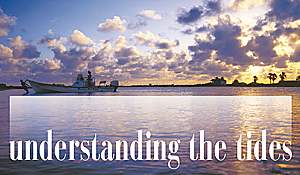|

How to turn the TF&G Almanac
into a precise fishing formula that will give you
a decided edge when angling the Texas Coast
By Chester Moore, Jr.
Judging from questions I get from readers, tides cause more confusion
among coastal fishermen than any other subject.
As outdoor editor of the Port Arthur News, readers frequently
contact me to answer questions they have about tides and tide
charts. It seems there is much misinformation regarding how and
when tides move and what natural forces influence their movement.
One of the questions I hear most often goes something like this:
"I saw where the low tide was going to be at 11:15, but the
water was up above the boat dock. How could the tide be so high
during the low tide period?"
To answer this and any other question about tides, it is best
to take a good look at what tides are and exactly what forces
cause them.
Tides are the periodic rise and fall of all ocean waters. They
are caused in two different ways: gravity upon the water from
the moon and sun, and gravity upon the water from the earth.
My mentor, veteran outdoor writer Ed Holder, told me that the
easiest way to understand how these tidal movements work is to
compare them to a wave.
"In essence," he says, "a tide is a large, slow-moving
wave that starts off in the ocean, moves through a pass and ends
up in the back of a bay or upland into a river system. And it's
all influenced by the elements."
Remember that most waves are influenced by wind and tides are
no different. This is why some low tides aren't always so low.
A strong southerly wind pushes a lot of water into a bay system,
causing unusually high tides, even sometimes during periods when
moon or solar patterns call for low tides.
During this past spring and summer, south winds prevailed along
the Upper Texas Coast and played heck with the tide tables. What
were supposed to be low tides ended up being more than a foot
above normal because of the constant, pounding south wind.
Conversely, north winds will push water out of an ecosystem.
That's why during the fall we get such low tides. "Blue northers"
in conjunction with a strong tidal pull will really drain an area
and help to cleanse coastal marshes.
Moving on, but still keeping with the idea of viewing the tide
as a wave, it's very important for anglers to understand that
tidal strength at points away from the immediate coastline won't
be as strong as those at a pass near the Gulf.
"You've got to realize that like any wave, a tide weakens
as it move inland," Holder says. "So your strongest
tide will be near the Gulf and the weakest will be far into the
bay or river."
The Port Arthur News' tides are given for the Old Coast Guard
station at Sabine Pass. But at Stewt's Island, on the north end
of Sabine Lake, what is a 3-foot tidal change at the pass may
be reduced to somewhere between 2 and 2-1/2 feet. And 10 miles
up the river at the Interstate 10 bridge at the Neches River,
it might be only a 1-foot change. But you'll need to remember,
the wave weakens as it moves farther inland.
Another question I'm frequently asked is: "We saw on the
television that we would have a high tide about 5:00 a.m., so
we got out there an hour early and the tide didn't move for hours.
Was the TV tide table wrong?"
Probably not. Most times when I get a question like this, it's
from someone who doesn't understand one very important point about
tides. That point is, the tides given in some papers and on television
merely tell you when the lows and highs occur. However, they don't
tell you how much change will occur between tides. Texas Fish
& Game® provides that information in a chart which appears
in the back of each issue-a vital part of the "TF&G Almanac"-which
details tidal movements (the degree of rise and fall) and a "Tidal
Correction Table" for various points along the coast as
well as moon phases, moon rise/set times and peak activity periods
for fish and game.
Let's take this situation, for example. Say for a Tuesday, the
tables will predict two high tides and two low tides. The highs
will occur at 3:35 a.m. and 12:58 p.m. and the lows will occur
at 8:55 a.m. and 8:37 p.m.
That's all the information you get in some tide tables.
continued
page 1 / page 2
| 




